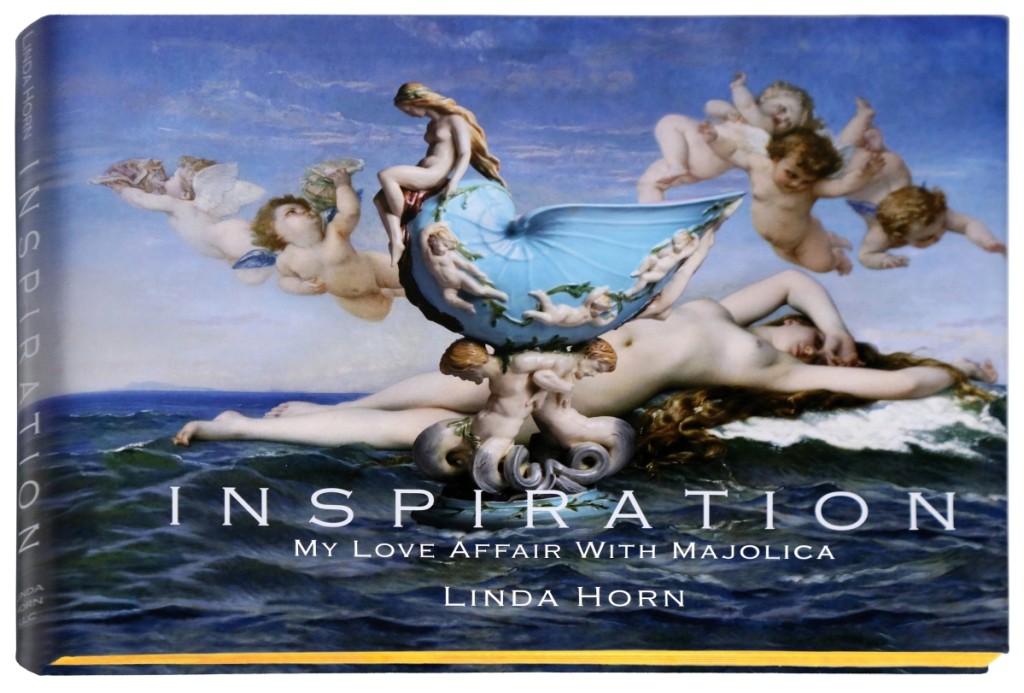Executive producer, director, cameraman, magazine editor and fashion director Linda Horn has long been a collector of majolica – playful, colorful earthenware pottery decorated with tin-lead glazes that originated in the Spanish island of Majorca. Horn’s just-published first book, Inspiration, combines European paintings and her collection of majolica, which she wanted to share with lovers of this whimsical pottery. Antiques & The Arts Weekly caught up with the globe-trotting aesthete to uncover the source of her inspiration for the book and how she came to connect the fine and decorative arts, which, in her words, she says are “both true works of art!”
What was the first piece of majolica you acquired? When was that and why did you buy it?
Oh, that was a very long time ago, more than likely in the late 1970s, before I even knew a thing about Minton or George Jones or any of the other important potters. It was probably a little piece of American majolica, not very important and probably cost me around $30. I was taken by the bright colors and interesting shape of a sweet shell and seaweed pattern teapot.
When did you first have the idea that majolica might have been inspired by paintings? What was the inspiration for your Inspiration?
I started to wonder how these Nineteenth Century artists could take a simple mound of clay and sculpt these astonishing creations. They had to have been influenced by something, they had to have seen something that put this particular image in their mind. I started looking at paintings from the Seventeenth, Eighteenth and Nineteenth Centuries. There were images in these paintings that seemed to be directly copied by these Nineteenth Century sculptors, actual objects or animals, and there were other paintings that I felt could have possibly been the artists’ inspiration. Hence, an idea was created. Their inspiration was my inspiration.
Has your collecting gone through different phases or followed a particular path?
I don’t follow a particular path in anything I do. I find I’m influenced by everything around me-I see something and it will spark my imagination and send me into a direction that I concentrate on and see what I can create from this inspiration. This is the way I treat everything in my life. Nature and the universe are my teachers and they guide my reactions and what direction I take in that phase of my life.
Collectors sometimes have great stories about pieces they’ve collected…what’s your most memorable moment?
I think most collectors would have to comment on the “game” of the auction-seeing something that they felt would be a very important addition to their collection and at the same time not revealing to the other competitors how much they wanted it, obviously the idea is to get the piece you want at the best price possible. Sometimes you win, sometimes you lose, but you tend to always remember the stories when you bought this incredible piece for next to nothing and not want to remember the times it went the opposite way and you were too caught up in the auction and too competitive to stop bidding. It’s all a game and we all know we win some and we lose some. And, of course, our most memorable moments are when we achieve beyond our greatest expectations and surprise even ourselves.
Do you look to upgrade models you have already acquired?
I try to collect examples that represent the best color and attention to detail that satisfy my critical eye.
Do you have a specific piece – a ‘Holy Grail’ – you are looking for that has eluded you?
A specific piece-that’s the challenge with majolica. You think you’ve seen it all, and then something comes up that you’ve never seen or suspected existed. It’s a never- ending hunt,a story without an ending.
Asking a collector to name their favorite piece is like asking a parent to say who their favorite child is, but if there was a fire and you could save just one piece…?
If there was a fire, I would save my dogs and feel that it must be time for me to start a whole new collection of something totally different, maybe Buccellati birds.
For people who might want to start collecting majolica but are not sure where to start, what advice would you give them?
Well, since they profess an interest in collecting then they must like majolica-so I might [ask] is this something you just want to collect to decorate an armoire, or do you have interest in a collection of teapots or a collection of animal figures or a collection of flowers or a collection of game dishes? Maybe it’s miniatures or maybe it’s only large ceremonial pieces. I think you have to know a little bit about the person to know what kind of advice to give.
Are there still companies who make quality majolica reproductions that you would/do collect, or are you a purist and only collect antique and/or vintage majolica?
There really never has been good reproductions of majolica. There are certainly things that have the feeling but in no way the craftsmanship and color of this Nineteenth Century product.
In summary, what do you want the legacy of this book to be?
Now, by publishing this book-a work that combines fine arts and my majolica, I can share my very private collection with the true lovers of this whimsical pottery and also the admirers of these famous paintings-both true works of art!
-Madelia Hickman Ring






